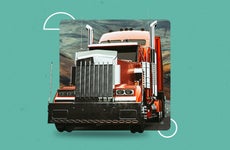Pros and cons of semi-truck financing

The Bankrate promise
At Bankrate we strive to help you make smarter financial decisions. While we adhere to strict , this post may contain references to products from our partners. Here's an explanation for .
Key takeaways
- Semi-truck financing can be easier to secure than other business loans, even if you are a new business or have bad credit
- Businesses can take advantage of depreciation and the Section 179 deduction to save money on taxes when buying equipment
- Online lenders and direct lenders specializing in the trucking industry can provide fast funding and flexible payment options.
Financing a semi truck can help ease the startup costs as an owner-operator. And the good news is that semi-truck financing can be easier to secure than other business loans if you’re a new business or have bad credit.
While semi-truck financing is easier to secure, there are still additional costs associated with it, like a down payment and loan fees. Additionally, your truck will be used as collateral to secure the loan. Before agreeing to a semi-truck loan, you’ll want to review the pros and cons to ensure it’s the right choice for your business.
Pros of semi-truck financing
Not only does financing your semi truck lower your upfront costs, but it also provides many other advantages to get your business off the ground. Let’s dig into all the benefits of getting a semi-truck loan.
Fast funding
Semi-truck financing is a straightforward type of loan. You can easily show the lender what you’re using the loan for and the contracts you have to provide income for payments. You’ll also use the truck as collateral, giving the lender a secure reason to approve the loan.
Semi-truck loans can get approved in as little as a few days. But the exact time to get funding depends on the lender, the type of loan and the characteristics of your truck.
Tax benefits
You can deduct ordinary and necessary expenses for your semi truck come tax time if you’re a self-employed driver. You won’t be able to use the standard mileage deduction for business vehicles, though, so you’ll need to calculate your exact vehicle expenses.
-
- Depreciation
- Fuel and oil
- Insurance
- Leasing costs
- Log books
- Lumper fees
- Maintenance and repairs
- Registration
- Tires
- Tolls and parking fees
- Truck washing
If you’re employed by a trucking company, your company will pay for these vehicle expenses. However, employees can still deduct travel expenses when away from home, such as lodging, meals and laundry costs.
To deduct travel expenses, you have to meet both requirements:
- Be traveling away from home for a period that’s longer than a normal workday
- Must stop and sleep to keep up with work demands
No matter what expenses you’re claiming, keep tidy receipts and records to back up what you claim on your taxes.
Tax benefits for financed semi trucks
When you finance a semi truck, you can deduct your annual interest payments on your taxes. You can make this deduction each year for the entire life of the loan.
The IRS also considers your financed vehicle a business asset, which means that you can claim depreciation even though you don’t fully own the truck.
What is Section 179 of the IRS Tax Code?
When you claim depreciation for commercial equipment, you typically depreciate part of the equipment’s value over its usable life. However, Section 179 allows you to deduct part or all of your equipment’s cost during the first year that you place it in service. You don’t have to take the full Section 179 deduction. If you don’t, you can depreciate the rest of your semi truck’s value on your taxes over the life of the truck.
This deduction encourages small businesses to invest in commercial equipment that will grow their business since they can write off the entire cost. Beginning in 2024, businesses can claim a maximum deduction of $1,220,000, according to the IRS. If the total value of your property goes over $3,050,000, you have to reduce the tax deduction by the excess amount.
For example, if you buy a fleet of trucks worth $3,100,000, you exceed the $3,050,000 limit by $50,000. Your total tax deduction for depreciation would be $1,220,000 – $50,000 = $1,170,000 (or $1.17 million).
So unless you buy a fleet of semi trucks, you can deduct the full cost of your owned or financed truck on your taxes.
Spread out the cost of a large purchase
Semi trucks are an integral part of your work as a trucker, but shouldering the entire cost at once may not be feasible or may strain your finances. You can shell out anywhere from $70,000 to $200,000 for a truck, depending on the model and whether it’s new or used.
Financing your semi truck costs more than buying outright since you have interest and fees. But spreading the cost out over three to five years makes payments manageable, and you can pay for the truck as you generate income with it. In other words, let the semi truck pay for itself.
Accessible to startups and bad-credit borrowers
You’ll typically finance a semi truck through an equipment loan, which is a secured loan. Secured loans are less risky to the lender because they can recoup the loan by seizing the asset you used as collateral. Because you can use your high-value semi truck to secure the loan, you could get semi-truck financing for startups or with poor credit.
Leasing options
Leasing your truck is ideal if you don’t qualify for a loan or you don’t want to chance defaulting on a loan if your contracts go sideways. Some leasing companies don’t require a down payment and most offer vehicle maintenance packages, helping you get on the road for a predictable monthly payment.
You could also get matched with a much newer truck than you could afford with a loan. Plus, you can opt to buy your truck at the end of your lease. But you might pay more in fees by the end than you would if you financed a truck.
Cons of semi-truck financing
The main downside to semi-truck financing is the variety of costs that you’ll bear over the life of the loan. Take a look at what costs you’ll be expected to pay.
High purchase costs
Even though you’re paying for it over time, a semi truck is going to cost you tens of thousands of dollars no matter what type of financing you choose.
For example, if you need a business loan for $100,000 to finance a semi truck for seven years at 6 percent interest, you’re looking to pay around $1,461 per month — and that’s with a prime interest rate. Over the life of the loan, you’ll pay an additional $22,712 above the cost of the vehicle. Get an idea of your monthly repayments ahead of time before you apply for a loan.
High interest and loan fees
Most lenders offer their prime interest rates as low as 6 percent if you have a credit score in the upper 600s or higher. But if you have bad credit or you’re a first-time owner-operator, you might see interest rates between 30 and 100 percent.
Let’s put that high interest in perspective. If you finance a $100,000 semi truck for seven years at 30 percent interest, you’ll end up paying around $2,860 in monthly repayments. The total interest for the entire loan would come to $140,181.
Not to mention, you have the regular business loan fees to watch for. Depending on the lender, you may pay an origination fee of anywhere from 0.5 to 8 percent of the loan amount. You may also pay fees to apply for the loan, get the truck appraised and check your credit.
Requires down payment
You’ll most likely need to put 10 to 20 percent down when getting a loan for your semi truck. The down payment lowers the risk of financing for the lender, which can be helpful if you have subprime credit. But it means you need a hefty sum on hand before you can get your truck.
Requires time in business
Many lenders require that you have a history of truck driving before they’ll finance a semi truck for you. For example, banks may want to see one to two years in the industry, while online lenders may allow as little as a six-month driving history. This requirement makes it difficult for new drivers to become owner-operators.
How to determine if semi-truck financing is right for you
Weighing semi-truck financing pros and cons can help you avoid a potentially expensive mistake. Semi-truck financing is right for businesses that are confident repayments fit in their budget, have decent credit and can afford to purchase a well-vetted vehicle.
Financing a semi truck may also be a wise decision if you’re eligible for a good interest rate and plan on keeping the vehicle for the long run. But, if the cost of semi-truck financing doesn’t fit in your business budget, or you may have trouble managing your semi-truck loan, you’ll want to consider alternatives.
Bottom line
Financing a semi truck helps you cover the cost of an expensive asset without depleting your financial resources before you even get on the road. Yet any business loan will set you back in interest and fees versus buying the truck outright, especially if you apply with poor credit.
Your best bet is to shop around with different lenders to see what types of loans and interest rates you qualify for. If you’re in good financial standing, try a traditional bank for the lowest rates. Otherwise, you might want to work with an online or direct lender that specializes in the trucking industry. If the cons outweigh the pros, consider looking at the alternatives to semi-truck financing to find the right option for your business.
Frequently asked questions
-
Most lenders will finance a semi truck for up to five years. Some lenders offer terms as long as seven years, while a few will customize the repayment terms based on your financial situation.
-
If you finance your semi truck through a traditional bank, you’ll need a credit score of 660 or higher. Online lenders typically set their minimum credit scores in the low 600s.If you have poor credit, you can find online or direct lenders that offer loans for bad credit borrowers. You may also be able to get approved with bad credit by offering a higher down payment or extra collateral to back the loan.
-
You’re most likely to get semi-truck financing without a down payment if you go with a leasing company like National Funding or Ryder. Most leases give you the option to buy the truck at the end, so ownership is still possible.If you want to finance without a down payment, you’ll need to find a lender willing to work with you. Having a relationship with the lender will give you a better chance of getting approved. They may also require excellent credit and strong finances to repay the loan and expect to pay a higher interest rate than you would if you put money down.
Related Articles



